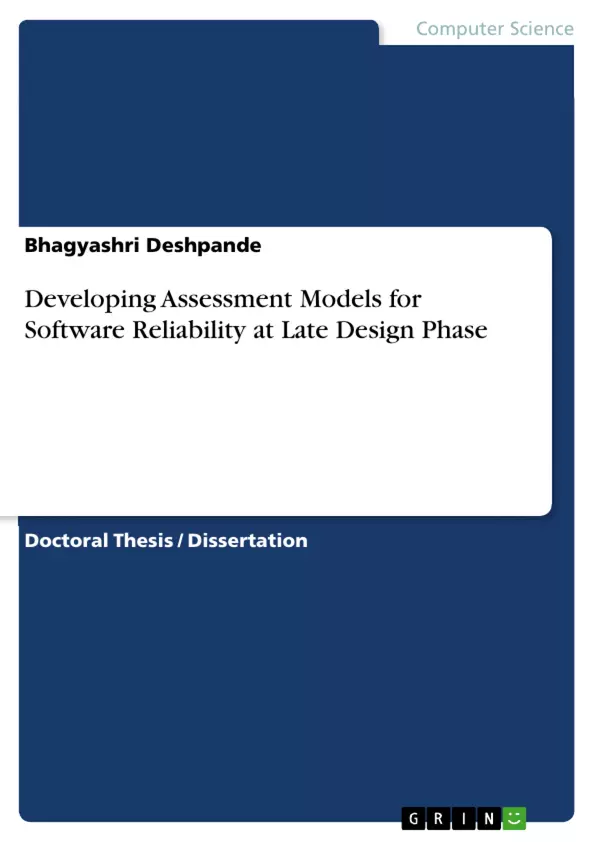In this thesis report the pertinence of the models (Neural Network model and Hellinger Net model) for better software reliability prediction considering the parameters and software metrics affecting the software design in a real environment is described. And a method of software defect detection and software reliability assessment using NN model and Intelligent Water Drop (IWD) Technique is presented. Built on a Neural Network (NN), two models are developed which predicts the software reliability in a more accurate manner. There are two kinds of hybrid models developed. One uses IWD with NN and another is IWD with Spiking Neural Network (SNN).
For both, the modelling feature selection technique and learning algorithm is implemented and the data representation methods and some metrics associated with software reliability models are discussed. Various datasets containing metrics values with software failures are applied to the proposed models. These datasets are acquired from variety of software projects.
Inhaltsverzeichnis (Table of Contents)
- CHAPTER 1: INTRODUCTION
- 1.1 Research Problem
- 1.2 Objective of the Research
- 1.3 Scope of the Thesis
- 1.4 Organization of the Thesis
- CHAPTER 2: LITERATURE SURVEY
- 2.1 Software Reliability Assessment
- 2.2 Early Software Reliability Assessment Techniques
- 2.3 Reliability Assessment Techniques at Design Phase
- 2.4 Existing Research on Reliability Prediction Models
- 2.5 Summary and Future Scope
- CHAPTER 3: PROPOSED SOFTWARE RELIABILITY ASSESSMENT MODELS
- 3.1 Proposed Models
- 3.2 Evaluation of the Proposed Models
- 3.3 Implementation of Proposed Models
- 3.4 Summary
- CHAPTER 4: CASE STUDY
- 4.1 Case Study Description
- 4.2 Implementation of Proposed Models for Case Study
- 4.3 Results and Analysis
- 4.4 Summary
- CHAPTER 5: CONCLUSION
- 5.1 Summary and Contributions
- 5.2 Future Research Directions
Zielsetzung und Themenschwerpunkte (Objectives and Key Themes)
This thesis aims to develop assessment models for software reliability at the late design phase. It aims to address the challenges of traditional reliability assessment approaches, which are often ineffective at this critical stage of development. The research delves into exploring the reliability of software systems during the design phase, aiming to create models that can more accurately predict and assess software reliability early in the development process.
- Software Reliability Assessment
- Reliability Assessment Techniques
- Design Phase Reliability Assessment
- Software Reliability Prediction Models
- Case Study Analysis
Zusammenfassung der Kapitel (Chapter Summaries)
Chapter 1: Introduction introduces the research problem, objectives, scope, and thesis organization. It outlines the limitations of current reliability assessment approaches, particularly during the design phase, and highlights the need for novel solutions.
Chapter 2: Literature Survey provides a comprehensive overview of existing research on software reliability assessment. It examines early assessment techniques, explores methods for assessing reliability during the design phase, and discusses existing research on reliability prediction models. This chapter establishes the context for the proposed research.
Chapter 3: Proposed Software Reliability Assessment Models presents the core contribution of the thesis. It details the proposed models, their evaluation methodologies, implementation strategies, and summarizing the key features and benefits of these models.
Chapter 4: Case Study demonstrates the practical application of the proposed models. This chapter describes the case study scenario, outlines the implementation process, analyzes the results, and draws conclusions based on the empirical evidence.
Schlüsselwörter (Keywords)
Software reliability, reliability assessment, design phase, reliability prediction models, software quality, software engineering, case study, empirical analysis.
- Arbeit zitieren
- Bhagyashri Deshpande (Autor:in), 2021, Developing Assessment Models for Software Reliability at Late Design Phase, München, GRIN Verlag, https://www.grin.com/document/1215025



